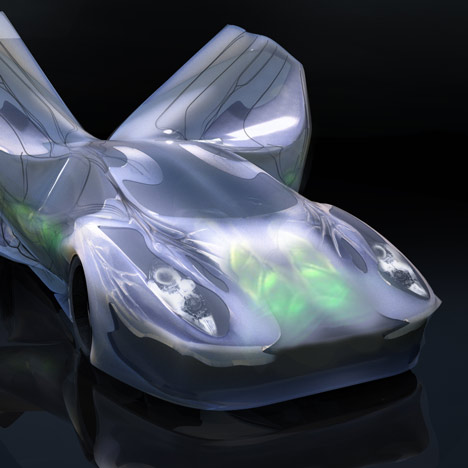
Semi-Rigid Car by Emergent
This concept car by Los Angeles architects Emergent is made of cartilage and makes its own fuel from algae.
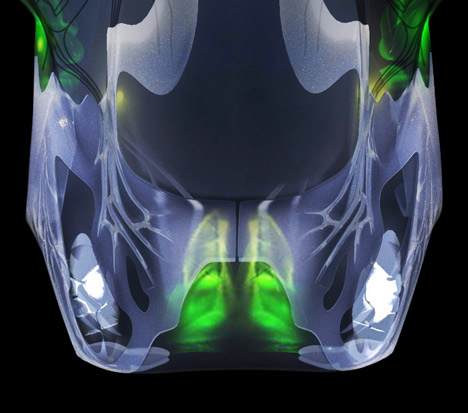
The bio-engineered car would be grown instead of manufactured, with doors and bonnet made of synthetic skin and the chassis capable of folding up like a limb so the vehicle can be transported easily.
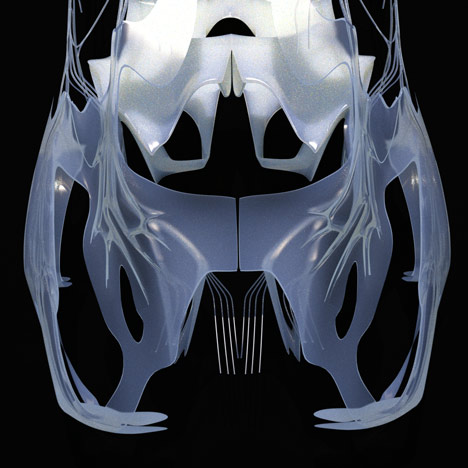
The Semi-Rigid Car, designed to explore futuristic manufacturing processes, would be 3D-printed in one piece from a mixture of organic materials as well as polymers, rubbers, resins and silicone.
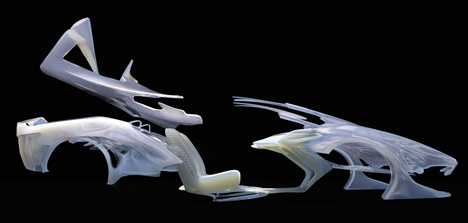
Doors would be controlled by tendon-like mechanisms, curling back in response to chemical signals emitted by the owner.
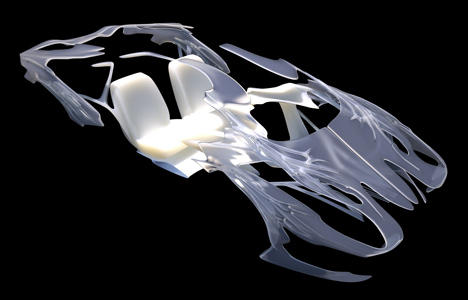
Algae tanks inside the car would provide fuel with LED lighting inside the tanks allowing production to continue at night, causing the semi-transparent bodywork to glow.
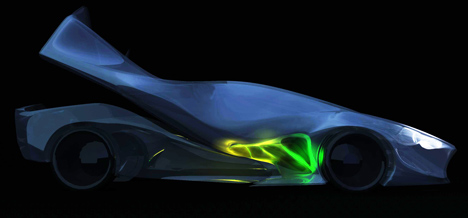
The following details are from Emergent:
The Semi-Rigid Car
Concept cars in the history of the automotive industry, though often produced for brand marketing purposes, constitute, arguably, an avant-garde. The evolutionary development of that industry has always depended on the deterritorialization of domesticated forms of transportation through the introduction of mutations into the system. There are several biases in concept car design, of course, ranging from those which focus on advanced material applications, drive-train, fuel, safety, and other performance dimensions, such as in Formula One, to those which focus on contemporary body styling on a relatively indifferent, if not conventional chassis.
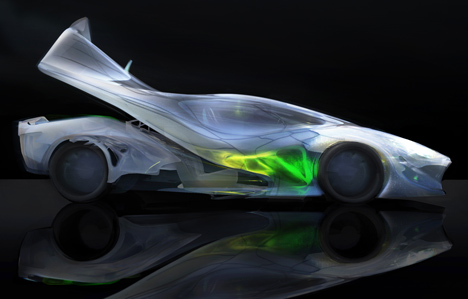
These biases are also evident in contemporary architecture, in the current split between discourses of synthetic materiality and effects (formalism) vs. approaches based on the behavior of physical matter. In car design, however, this split has not become so academically entrenched, and the vast majority of successful concept car designs leverage crossovers between formal features and material behaviors. It is this kind of synthetic thinking which drives our design for the Semi-Rigid Car (SRC), and our hopes for architecture.
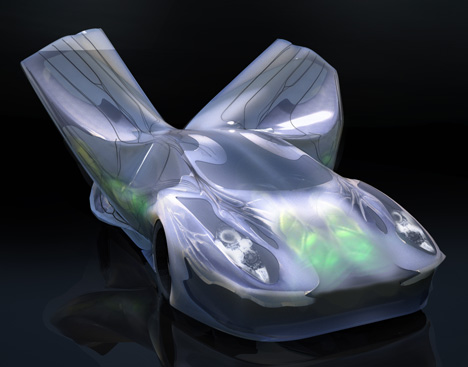
Multi-materiality
The SRC is an experiment underwritten by the recent revolution in what we call 'multi-materiality' in rapid prototyping. With the invention of 3D printers which not only print in multiple materials simultaneously, but in gradient mixtures of these materials, fabrication as we have understood it is transformed. No longer based on tectonics or assembly of parts, fabrication has suddenly become a new form of alchemy.
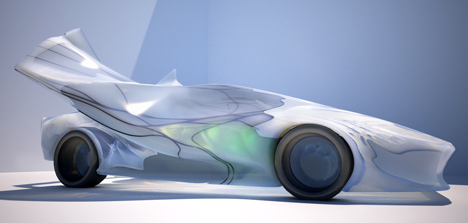
Variable opacity, color, ductility, and rigidity are all in play, all at once, opening up radical possibilities for embedding structure, energy systems, and visual effects across a continuously changing material matrix. The mechanical appearance and behaviour of steel, glass, sheet metal, and fasteners is replaced with a new language of blending based on compositing synthetic and biological materials, not in layers, but in new molecular arrangements. The combinatorial range of capacities and aesthetics of polymers, resins, rubbers, silicone, cartilage, and cuticle puts into question the tired frame-and-infill model of design, which is based on extreme disparity of material capacities within hierarchical assemblies. In terms of automobile structural design over the last century, and its oscillations between vector frame and unibody (monocoque) models, the paradigm of multi-materiality offers alternatives away from both mineral logic and machine logic.
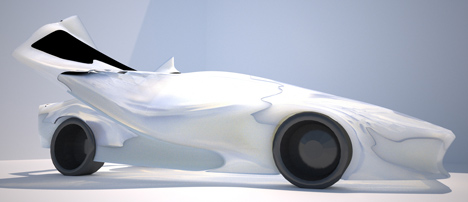
Synthetic Cartilage and Actuated Skin
The multi-material range from soft to semi-rigid to rigid is applied across the discontinuous chassis and across the skin of the car. The base material, silicone, varies in thickness and density across the body, sometimes transforming into zones of semi-rigid synthetic cartilage. Similar to a shark skeleton, which is all cartilage, zones of semi-rigidity can occur as bundles of strands or plate-like formations.
The "crumple-zone" model of crash safety in unibody construction, where front and rear zones self-destruct in order to absorb impact forces, is replaced by the lively springiness of the semi-rigid construction. The car instead flexes and bounces back from impact. In addition, pressurized air pockets within the skin are triggered upon impact with other cars or pedestrians, integrating external air-bag technology in a way that would be impossible in a sheet metal body.
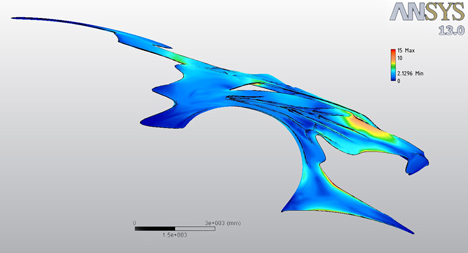
Thickness variability of the base material generates variable opacity creating transparent zones for viewing out as well as deep atmospheric views inside the body of the car. The thickest zones are embedded with fluid reservoirs containing algae colonies, forming a photo-bioreactor for the production of bio-fuel. This fuel, similar to vegetable oil, is a renewable resource, and more importantly, produced by the car itself. The introduction of LED lighting into these reservoirs enables 24-hour biofuel production, and creates a deep glow through the silicone-like gel matrix at night.
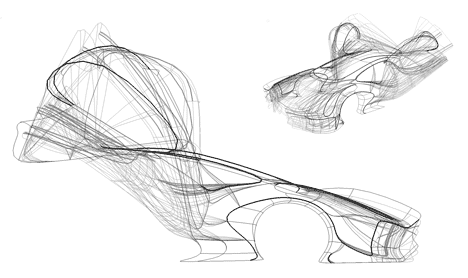
In contrast to the conventional mechanical movements of doors and hoods, involving frames and hinges, openings in the SRC are boneless and hinge-less (or better, giant living hinges). The 'doors' are slabs of synthetic skin, triggered by tendon-like actuators which respond to the pheromonal signature of the car's owner. When they open, they quiver and curl, exhibiting behaviours which could not possibly involve sheet metal and hardware.
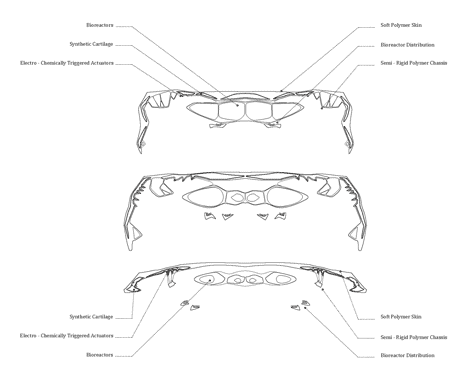
Click above for larger image
International distribution of the SRC from factory to point of purchase will not involve the unsustainable system of shipping completed cars. The flexibility of the semi-rigid chassis will allow the car to folded or rolled up for transport so it will spring open and settle. The higher degree of rigidity required for driving will be reached by pumping a gaseous catalyst into the hollow chassis which will cure an internal pre-preg polymer lining.
Finally, the wheels fuse rim and tire into a continuous gradient of rubber to rigid resinous biopolymer. Replacements can be 3D printed.